EXECUTIVE SUMMARY
|
Critics of the Endangered Species Act contend it is a failure because only 1 percent of the species under its protection have recovered and been delisted. The critique, however, is undermined by its failure to explain how many species should have recovered by now. It is a ship without an anchor.
To objectively test whether the Endangered Species Act is recovering species at a sufficient rate, we compared the actual recovery rate of 110 species with the projected recovery rate in their federal recovery plans. The species range over all 50 states, include all major taxonomic groups, and have a diversity of listing lengths.
We found that the Endangered Species Act has a remarkably successful recovery rate: 90 percent of species are recovering at the rate specified by their federal recovery plan.
On average, species recovered in 25 years, while their recovery plan predicted 23 years — a 91 percent timeliness accomplishment.
We confirmed the conclusion of scientists and auditors who assert that the great majority of species have not been listed long enough to warrant an expectation of recovery: 80 percent of species have not yet reached their expected recovery year. On average, these species have been listed for just 32 years, while their recovery plans required 46 years of listing.
Many species that have not been listed long enough to reach their recovery goals increased dramatically since being protected by the Endangered Species Act:
| California least tern | 2,819% increase in nesting pairs |
| San Miguel island fox | 3,830% increase in wild foxes |
| Black-footed ferret | 8,280% increase in the fall population |
| Atlantic green sea turtle | 2,206% increase in nesting females on Florida beaches |
| El Segundo blue butterfly | 22,312% increase in butterflies |
While many species are near or above the numeric population goal set by their recovery plan and will likely be delisted in the next 10 to 15 years, others also have strong recovery trends, but will not be delisted for many decades because their recovery plans require that much time to fully secure their fate.
The study’s findings are similar to a 2006 analysis of all federally protected species in the Northeast, which found 93 percent were stabilized or improving since being put on the endangered species list and 82 percent were on pace to meet recovery goals.
When judged in the light of meeting recovery plan timelines for recovery, the Endangered Species Act is remarkably successful. Few laws of any kind can boast a 90 percent success rate.
The Endangered Species Act is America’s strongest environmental law. It has safeguarded 99 percent of the 1,482 species under its care from extinction. Were it not for the Act, 227 of these plants and animals would have disappeared by 2006, and even more by 2012.(1) This is in sharp contrast to the much higher extinction rate of species not protected by the Act.(2)
Yet critics such as Doc Hastings, chairman of the Committee on Natural Resources of the U.S. House of Representatives, assert that the Act is a failure because relatively few species have been removed from the endangered list:
“The purpose of the ESA is to recover endangered species — yet this is where the current law is failing — and failing badly. Of the species listed under the ESA in the past 38 years, only 20 have been declared recovered. That’s a 1 percent recovery rate.”(3)
These critics do not explain, however, why they believe more species should have recovered by now, or why the current recovery rate is evidence of failure rather than success.
This question has been examined by scientists and the U.S. Government Accountability Office, both of which concluded that the success of the Endangered Species Act cannot be judged by the number of recovered species. This is because most species have not been listed long enough to reach their planned recovery level:
“The recovery plans we reviewed indicated that species were not likely to be recovered for up to 50 years. Therefore, simply counting the number of extinct and recovered species periodically or over time, without considering the recovery prospects of listed species, provides limited insight into the overall success of the [U.S. Fish and Wildlife] Services’ recovery programs.”(4)
Or more succinctly: “Evaluating success as a measure of how many species are delisted is a non-informative metric.”(5)
The Endangered Species Act has been demonstrated to move species toward recovery: The longer they are listed, the more likely they are to be recovering.(6) But are species moving toward recovery fast enough? What is the proper measure by which to judge their speed?
To answer these questions, this report determines the population size and trend of 110 recovering endangered species, comparing them to the recovery goal and projected recovery date in each species federal recovery plan.(7) We also identify the conservation actions that most influenced the species’ recovery.
We identified 110 threatened or endangered species that have advanced toward recovery since being protected under the Endangered Species Act. As per the Act, we defined “species” as species, subspecies or distinct population segment as identified by their recovery plans. Some taxa such as the piping plover and green sea turtle, are listed at the species level, but have separate recovery plans and goals for subpopulations. Each of those subpopulations is treated as a species in this report.
We determined the population size for each species in as many years as possible with a particular emphasis on the time between listing and 2011. If range-wide population estimates were not available, we tracked alternative recovery indices such as the number of populations, population density, or size of occupied range. Care was taken to ensure trends were not significantly confounded by differences in survey effort, calculation methodology, or the discovery of previously unknown populations. Data sources included listing decisions, critical habitat designations, recovery plans, five-year reviews and other status assessments by the U.S. Fish and Wildlife Service and the National Marine Fisheries Service, published papers, gray literature produced by or for state, federal and private agencies, and data in the files of species experts. Each species typically had one to three readily identifiable experts, including the U.S. Fish and Wildlife Service or National Marine Fisheries Service recovery coordinator, who were knowledgeable about the state of survey efforts and population estimates.
The length of time each species was listed was defined as the difference between the date it was placed on the federal list and the earliest of either December 31, 2011 or the date it was removed from the list. If a species was first listed under a precursor of the Endangered Species Act of 1973, its listing date was set to December 28, 1973, the day the current law was enacted.
Each species’ most recent recovery plan was obtained from the U.S. Fish and Wildlife Service. From each plan we extracted the species’ recovery goals, which must be met for a species to be declared recovered. The criteria are typically a combination of goals for population size, number of sites, geographic distribution, demographic markers (i.e. risk of extinction or stability evidenced over time), habitat protection and management (i.e. formal commitments to long-term conservation). Not all recovery plans contained quantified goals.
We extracted each plan’s estimated time-to-recovery. This is the plan’s estimate of the time needed to achieve the recovery goals. (The current draft plan was used if it included a time-to-recovery while the current final did not.) Once the goal is reached, a formal delisting process can be initiated. At a minimum, this process includes development of a proposed delisting rule, subjection of the proposal to scientific peer review, publication of the proposal in the Federal Register to solicit public comment, and publication of a final rule in the Federal Register responding to the comments and peer review. In practice, this process often takes five years or more. We conservatively allowed two years for the delisting process, as that is the minimum time possible. Thus we defined “expected time-to-delisting” as “expected time-to-recovery plus two years.”
If a plan did not have a time-to-recovery estimate, we extracted its estimated time-to-downlisting from “endangered” to “threatened” status. If the estimate year in which downlisting goals would be completed was 2011 or later, the species was classed as having a post-2011 time-to-delisting.
A narrative account was created for each species describing its management and population history. The accounts were submitted to species experts for review. The accounts and accompanying population graphs are available at www.ESAsuccess.org. Citations for all species-specific information in this study are presented in the relevant status narrative. A recovery trend graph was created for each species and is available with citations at the same site.
90 Percent of Species Met Their Delisting Deadline
Ninety-nine of the 110 species have a federal recovery plan. Fifty-one of those include a projected delisting date or date before which delisting cannot occur (see Table 1). Thus there are 51 recovery deadlines against which to test whether endangered species are recovering on time.
● Forty-one of the deadlines (80 percent) occur after 2011; thus these species have not missed their delisting deadline.
● Ten of the deadlines (20 percent) occur by 2011. Nine of these species were delisted by 2011. Thus the 90 percent of species in this study met their recovery timeline.
To determine if this recovery rate is biased by some unknown characteristic of the 51 species with recovery timelines, we applied the same expectation — 20 percent recovered by 2011 — to the 59 species with no recovery plan or no recovery timeline. The group met the deadline with 100 percent success: 12 of the 59 species (20 percent) were delisted by 2011.
Our findings are similar to a 2006 analysis of all federally protected species in the Northeast, which found 93 percent were stabilized or improving since being put on the endangered species list and 82 percent were on pace to meet recovery goals.(8)
It is instructive to look at the one species that was projected to recover by 2011 but did not. The Endangered Species Act is absolutist regarding extinction; thus even though just one species missed its deadline, if the result was extinction, it would indeed have been failed by the Act.
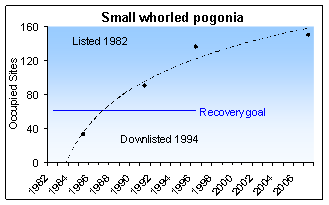 The small whorled pogonia is a widespread but rare orchid occurring in relatively open forest sites from New Hampshire to Georgia. It missed its delisting deadline by six years (124 percent of projected recovery period), but is far from “badly failing”; indeed the U.S. Fish and Wildlife Service classifies it as being “on the brink of recovery.” According to the agency, it is a victim of its own success: Due to its strong recovery trend, it has become a low priority to receive recovery funds compared to the many species that are more highly imperiled. Thus it has not been possible to complete the last habitat purchases, easements and/or management commitments needed to achieve the pogonia’s recovery plan delisting criteria.
The small whorled pogonia is a widespread but rare orchid occurring in relatively open forest sites from New Hampshire to Georgia. It missed its delisting deadline by six years (124 percent of projected recovery period), but is far from “badly failing”; indeed the U.S. Fish and Wildlife Service classifies it as being “on the brink of recovery.” According to the agency, it is a victim of its own success: Due to its strong recovery trend, it has become a low priority to receive recovery funds compared to the many species that are more highly imperiled. Thus it has not been possible to complete the last habitat purchases, easements and/or management commitments needed to achieve the pogonia’s recovery plan delisting criteria.
The small whorled pogonia was listed as endangered in 1982. Its number of known sites grew from 33 to 150 between 1985 and 2007. Most of the upswing is due to greatly increased survey effort in response to the listing, but it also experienced true population growth and greatly increased habitat protection and restoration. It was downlisted to “threatened” status in 1994 —
more than a year sooner than projected by its recovery plan.
The 105 sites vastly exceed the recovery plan requirement that the pogonia exist at 61 sites. However, those 61 sites must 1) be permanently protected; 2) represent at least 75 percent of self-sustaining populations over a 10-year period; and 3) management commitments or sufficient habitat must exist to allow existing sites to expand. In its 2008 five-year review, the U.S. Fish and Wildlife Service concluded that the three additional criteria had not been met.
TABLE 1. 51 Species With a Delisting Date Estimated by Their Federal Recovery Plan
SPECIES |
Listing Date |
Years Listed |
Projected Delisting Date |
Projected Recovery Time (years) |
Actual Delisting Date |
Florida panther |
12/28/1973 |
38 |
11/1/2085 |
113 |
|
Western snowy plover (Pacific DPS) |
3/5/1993 |
19 |
8/13/2049 |
57 |
|
Utah prairie dog |
12/28/1973 |
38 |
9/17/2042 |
70 |
|
Hawaiian goose |
12/28/1973 |
38 |
9/24/2036 |
64 |
|
Short-tailed albatross |
7/31/2000 |
11 |
9/17/2035 |
36 |
|
Steller sea-lion (western DPS) |
4/5/1990 |
22 |
2/28/2033 |
44 |
|
Fin whale |
12/28/1973 |
38 |
7/30/2032 |
59 |
|
Laysan duck |
12/28/1973 |
38 |
7/7/2032 |
59 |
|
Puerto Rican parrot |
12/28/1973 |
38 |
5/9/2032 |
59 |
|
California bighorn sheep (Sierra Nevada) |
4/20/1999 |
13 |
9/24/2029 |
31 |
|
Bighorn sheep (Peninsular Ranges DPS) |
3/18/1998 |
14 |
10/25/2027 |
30 |
|
Shortnose sturgeon |
12/28/1973 |
38 |
12/15/2026 |
54 |
|
Kemp's Ridley sea turtle |
12/28/1973 |
38 |
9/22/2026 |
54 |
|
Hawaiian duck (koloa maoli) |
12/28/1973 |
38 |
10/28/2023 |
51 |
|
Hawaiian common moorhen (`alae `ula) |
12/28/1973 |
38 |
10/28/2023 |
51 |
|
Hawaiian coot (`alae ke`oke`o) |
12/28/1973 |
38 |
10/28/2023 |
51 |
|
Hawaiian stilt (ae`o) |
12/28/1973 |
38 |
10/28/2023 |
51 |
|
Atlantic hawksbill sea turtle |
12/28/1973 |
38 |
12/15/2022 |
50 |
|
Great Lakes piping plover |
12/11/1985 |
26 |
9/8/2022 |
37 |
|
Atlantic leatherback sea turtle |
12/28/1973 |
38 |
6/20/2019 |
46 |
|
Wood stork (U.S. breeding DPS) |
2/28/1984 |
28 |
1/27/2019 |
35 |
|
Okaloosa darter |
12/28/1973 |
38 |
10/26/2018 |
45 |
|
Gila trout |
12/28/1973 |
38 |
9/10/2018 |
45 |
|
Cui-ui |
12/28/1973 |
38 |
5/15/2018 |
45 |
|
Atlantic green sea turtle |
7/28/1978 |
33 |
10/29/2017 |
40 |
|
Lake Erie water snake (off-shore DPS) |
8/30/1999 |
12 |
9/19/2015 |
16 |
8/16/2011 |
Steller sea-lion (eastern DPS) |
4/5/1990 |
22 |
2/28/2015 |
25 |
|
Apache trout |
12/28/1973 |
38 |
8/26/2013 |
40 |
|
Inyo California towhee |
8/3/1987 |
24 |
4/10/2013 |
26 |
|
Tulotoma |
1/9/1991 |
21 |
11/17/2012 |
22 |
|
Virginia round-leaf birch |
4/26/1978 |
34 |
9/24/2012 |
35 |
|
Bayou darter |
9/25/1975 |
36 |
7/10/2012 |
37 |
|
Delmarva Peninsula fox squirrel |
12/28/1973 |
38 |
6/8/2012 |
39 |
|
Atlantic piping plover |
12/11/1985 |
26 |
5/2/2012 |
27 |
|
Aleutian Canada goose |
12/28/1973 |
27 |
9/30/2007 |
34 |
3/20/2001 |
Concho water snake |
9/3/1986 |
25 |
9/27/2007 |
21 |
10/27/2011 |
Maguire daisy |
9/5/1985 |
25 |
8/15/2007 |
22 |
1/19/2011 |
Gray wolf (Western Great Lakes DPS) |
1/4/1974 |
38 |
1/31/2007 |
34 |
12/28/2011 |
Small whorled pogonia |
9/9/1982 |
29 |
11/13/2005 |
24 |
|
Eggert's sunflower |
5/22/1997 |
8 |
12/9/2004 |
8 |
8/18/2005 |
Robbins' cinquefoil |
9/17/1980 |
22 |
6/30/2003 |
23 |
8/27/2002 |
Bald eagle (continental U.S. DPS) |
12/28/1973 |
34 |
7/29/2002 |
29 |
7/9/2007 |
Tennessee coneflower |
6/6/1979 |
32 |
11/14/1995 |
17 |
8/3/2011 |
American burying beetle |
8/13/1989 |
22 |
>9/27/2014 |
|
|
Tidewater goby |
2/4/1994 |
18 |
> 12/7/2017 |
|
|
Northern aplomado falcon |
2/25/1986 |
26 |
> 6/8/2032 |
|
|
Whooping crane |
12/28/1973 |
38 |
> 3/30/2037 |
|
|
Guam rail |
4/11/1984 |
28 |
> 9/28/2017 |
|
|
California condor |
12/28/1973 |
38 |
> 4/25/2012 |
|
|
Florida manatee |
12/28/1973 |
38 |
> 10/3/2017 |
|
|
Texas wild rice |
4/26/1978 |
34 |
> 2/14/2027 |
|
|
Likelihood of Recovery Is Correlated With Percent of Recovery Time Elapsed
The longer species are listed, the more likely they are to be classified as improving by the U.S. Fish and Wildlife Service.(9) Thus one might expect that the longer species are listed, the more likely they are to be recovered. This was not the case. Among species with a projected recovery date, recovered species were listed for a shorter time (25 years) than still-endangered species (32 years).
Likelihood of delisting was instead correlated with the percent of the projected recovery period that had elapsed. Time elapsed for recovered species was 108 percent. For still-endangered species it was 70 percent.
The stronger relationship between actual time-to-delisting and projected time-to-delisting than simply to time-listed is further indication that the adequacy of recovery rates cannot be judged by the number of listed species, delisted species, age of the Act or even the length of time species have been listed. It must be judged by the relationship between actual and projected recovery times.
Case Study I: How Do Species Recover?
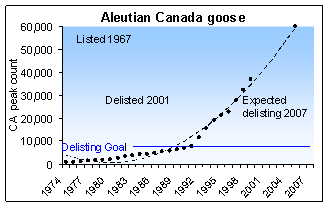 The Aleutian Canada goose was very nearly driven extinct by Arctic and red foxes introduced to its nesting islands in Alaska by the fur industry, and by excessive hunting and habitat destruction on its wintering and migration grounds in California and Oregon.
The Aleutian Canada goose was very nearly driven extinct by Arctic and red foxes introduced to its nesting islands in Alaska by the fur industry, and by excessive hunting and habitat destruction on its wintering and migration grounds in California and Oregon.
It was not seen at all between 1938 and 1962, when Bob “Sea Otter” Jones, manager of the Aleutian Islands National Wildlife Refuge, found a group of 250 geese on Buldir Island, a tiny speck of rock amid Alaska’s vast Aleutian Island chain. Buldir’s remoteness and rocky shoreline prevented fur trappers from stocking the island with foxes in the late 1800s and early 1900s, providing a refuge for the Aleutian Canada goose’s last remaining population.
The goose was listed as an endangered species in 1967, with Jones leading a desperate effort to remove the wily foxes and keep them off enough islands to give the goose a chance at survival. Meanwhile, thousands of miles away, graduate student Dennis Woolington discovered the goose’s wintering refuge in the San Joaquin and Sacramento valleys in California, which were quickly closed to hunting.
The national wildlife refuge system, which plays a critical role in the protection of hundreds of endangered species, was responsible for saving, then recovering, the Aleutian Canada goose. In 1980, the Alaska Maritime National Wildlife Refuge was established from 3 million acres of existing refuges and 1.9 million new acres to completely protect the Aleutian Canada goose’s nesting habitat. Refuges established to protect wetlands in California and Oregon protected the goose’s wintering and migration habitat, including the San Luis National Wildlife Refuge where Woolington later served as a biologist.
Protected from foxes, excessive hunting, and habitat destruction, and given a leg up with captive breeding and translocation to new islands, the Aleutian Canada goose population grew from 790 birds in 1975 to more than 60,000 in 2005. It was downlisted to “threatened” status in 1990 and declared recovered and removed from the endangered list in 2001, seven years earlier than projected by its recovery plan (and poignantly, three years after “Sea Otter” Jones’s death).
Following the U.S. recovery success, 19 captive geese were sent to Russia in 1992 to start a captive flock in Kamchatka. A joint Russian/Japanese/U.S. team is using the flock to re-establish the Aleutian Canada goose on former nesting islands in the Kuril Islands in Russia and on its former wintering grounds in northern Japan.
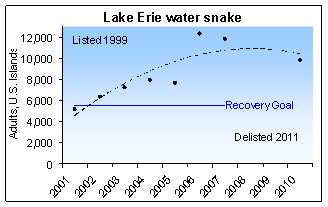 The Lake Erie water snake lives on small, mostly human-inhabited islands in Lake Erie. Though harmless, it was thought to be poisonous, dangerous or just creepy by local residents. It was killed in such large numbers that it was listed as a threatened species in 1999.
The Lake Erie water snake lives on small, mostly human-inhabited islands in Lake Erie. Though harmless, it was thought to be poisonous, dangerous or just creepy by local residents. It was killed in such large numbers that it was listed as a threatened species in 1999.
After listing, the U.S. Fish and Wildlife Service brought together a consortium of islanders, nonprofit organizations and government agencies to turn fear of the snake into pride. “LEWS News,” a local newsletter devoted to the Lake Erie water snake, was started. A poster contest was held for island students, with the winning entry used to spearhead a public-education campaign. Yard signs were distributed to people wanting to show support for their unique, but imperiled, reptile neighbor.
Kristin Stanford, a Ph.D. student at Northern Illinois University, became known as the “Island Snake Lady” for her scientific research and tireless education efforts, including a column titled “Ask the Snake Lady” in local newspapers and a “Respect the Snake” website.
Large tracts of the snake’s habitat were protected by a commitment by the Ohio Department of Natural Resources to manage all its island property as snake preserves and to purchase additional lands to protect them from development. Private lands were protected under preserves and conservation easements established by the Lake Erie Islands Chapter of Black Swamp Conservancy.
In response to these conservation efforts, the Lake Erie water snake’s population increased from 5,130 in 2001 to 9,800 in 2010. It was delisted in 2011, four years prior to its delisting projection.
Many Species Are Near or Above Recovery Levels and Will Likely Be Delisted in 10 to 15 years
The corollary to claiming the Endangered Species Act is 1 percent successful because only 1 percent of species has been delisted is that the other 99 percent are failures. In fact, many still-endangered species have increased dramatically since being placed on the list (see Table 2). Among them are the California least tern (2,819 percent increase in nesting pairs), San Miguel island fox (3,830 percent increase in wild foxes), black-footed ferret (8,280 percent increase in the fall population), Atlantic green sea turtle (2,206 percent increase in nesting females on Florida beaches) and El Segundo blue butterfly (22,312 percent increase in butterflies).
Table 2. Species With Population Increases of More Than 1,000% |
||
Species |
Increase |
Time Period |
El Segundo blue butterfly |
22,312% |
1984-2011 |
Big Bend gambusia |
19,900% |
1967-2005 |
Kemp's ridley sea turtle |
19,800% |
1979-2011 |
Black-footed ferret |
8,280% |
1987-2008 |
Okaloosa darter |
7,297% |
1978-2011 |
San Miguel island fox |
3,830% |
2004-2011 |
Virginia round-leaf birch |
3,596% |
1976-3003 |
Santa Rosa island fox |
3,400% |
2004-2011 |
California least tern |
2,819% |
1970-2010 |
San Clemente Island paintbrush |
2,507% |
1979-2011 |
Atlantic green sea turtle |
2,206% |
1989-2011 |
Virgin Islands tree boa |
1,872% |
1986-2008 |
San Clemente Island bush mallow |
1,500% |
1977-2007 |
Puerto Rican parrot |
1,471% |
1967-2011 |
Hawaiian duck |
1,417% |
1976-2007 |
American crocodile |
1,290% |
1975-2007 |
Atlantic leatherback sea turtle |
1,233% |
1979-2011 |
San Clemente sage sparrow |
1,233% |
1976-2010 |
Cui-ui |
1,200% |
1983-2005 |
Santa Cruz island fox |
1,052% |
2005-2010 |
Whooping crane |
1,009% |
1967-2011 |
Many other species have increased to population levels near or even above the delisting goals established in their recovery plans. Some of these, such as the Inyo California towhee, are ready to be delisted. Others, such as the small whorled pogonia, still need to achieve nonpopulation goals related to habitat protection. Many will be delisted in the next 10 to 15 years.
Case Study II: Species Near or Above Recovery Plan Goals
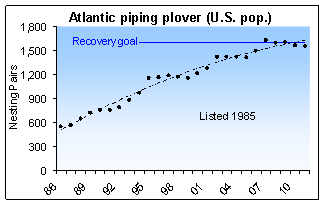 |
Atlantic piping plover populations declined due to hunting and the millinery trade in the 19th century. With these eliminated, it increased in the first half of the 20th century, but began declining after 1950 due to development, dramatically increased beach recreation by humans, and predation by native and introduced predators. Following its listing as an endangered species in 1985, habitat protection and control of recreationists and predators led to an increase in the U.S. population from 550 pairs in 1986 to 1,550 in 2011. The U.S. population reached its overall recovery goal in three of the past five years, but some of its subpopulations haven’t reached recovery yet, and its associated Canadian population has grown little. |
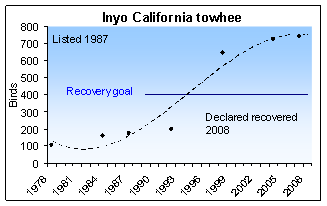 |
The Inyo California towhee occurs in a single, arid mountain range in Southern California. Its habitat was degraded by cattle, feral horses, burros, off-road vehicles, campers and hikers. It was listed as endangered with critical habitat in 1987. Its population remained between 100 and 200 birds from 1978 to 1992 and then began increasing in response to habitat protection efforts, reaching 741 in 2007. It reached its 400-bird numeric delisting goal in the mid-1990s. In 2008 it was declared recovered by the U.S. Fish and Wildlife Service, but is still listed. |
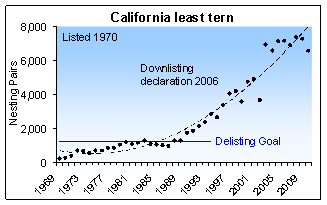 |
California least tern populations crashed in the late 19th century due to collection by the millinery trade. Declines in the 20th century were driven by development, recreational crowding at beaches, and anthropogenically exacerbated predation by wildlife. By 1970, when the tern was listed as endangered, just 225 pairs remained. Intensive habitat protection, predator control and recreation management increased the tern to its overall delisting goal of 1,200 pairs in 1988 and to 6,568 pairs in 2010. The U.S. Fish and Wildlife has declared that it should be downlisted to “threatened,” but is not yet ready for delisting because subpopulation, geographic distribution and population security goals have not yet been met. |
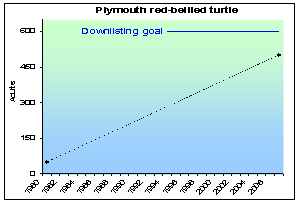 |
The Plymouth red-bellied turtle expanded from fewer than 50 turtles in 12 ponds, when it was listed as an endangered species in 1980, to 400 to 600 turtles in 20 ponds by 2007. It was close to meeting its downlisting goal in 2007 and may well have reached it since then. In 2007 the U.S. Fish and Wildlife Service determined that while the turtle was at or near its 500-adult population goal, its populations were not yet large or secure enough to have met the 15 self-sustaining populations goal. The red-bellied turtle benefited from the designation of critical habitat zones in 1980 and the establishment of a national wildlife refuge for its conservation. Between 1985 and 2006, 2,725 head-started turtles were collected from the wild as eggs, raised in captivity to a size safe from predators, and then released back into the wild. This ongoing program is responsible for raising the adult population by several hundred turtles and expanding its range to numerous new ponds. Many of the headstarted turtles are raised and reintroduced by schoolchildren. Overall, 12 species are in the process of being downlisted or delisted by the U.S. Fish and Wildlife Service or the National Marine Fisheries Service (see Table 3), including the eastern population of the Steller sea lion and the Yellowstone grizzly bear. |
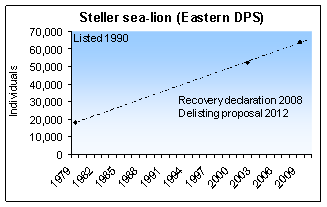 |
The Steller sea lion (Eastern DPS) declined due to exploitation, persecution and prey base declines. These threats substantially declined following its emergency listing as an endangered species in 1990 and designation of critical habitat in 1993. Its population increased from 18,040 in 1979 to 63,488 in 2009. In 2012 it was proposed for delisting due to high total numbers. Due to weak California trends and the southernmost portion of its range remaining unoccupied, however, it has not reached its subpopulation delisting goals. |
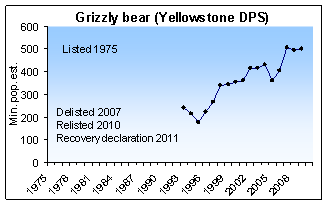 |
Grizzly bears were extirpated from most of the lower 48 states by killing, habitat destruction, roads and reduction of large wildland areas. By 1975 only six populations remained. Thanks to Endangered Species Act protections, the Yellowstone grizzly bear population increased from ~224 bears in 1975 to ~582 in 2010. It was delisted in 2007, relisted in 2010 due concerns about habitat loss and global warming, and declared recovered by the U.S. Fish and Wildlife Service in 2011. |
TABLE 3. 12 Species in the Process of Being Downlisted or Delisted
Species |
Listing Date |
Years Listed |
In Process |
Steller sea lion (eastern DPS) |
4/5/1990 |
22 |
Delist: proposal 2012 |
Grizzly bear (Yellowstone DPS) |
7/28/1975 |
36 |
Delist: 5-year review 2011 |
Inyo California towhee |
8/3/1987 |
24 |
Delist: 5-year review 2008 |
San Clemente Island paintbrush |
8/11/1977 |
34 |
Downlist: 5-year review 2007, proposal 2011 |
Tidewater goby |
2/4/1994 |
18 |
Downlist: 5-year review 2007, 90-day finding 2011 |
San Clemente Island lotus |
8/11/1977 |
34 |
Downlist: 5-year review 2007, proposal 2011 |
Wood stork (U.S. breeding DPS) |
2/28/1984 |
28 |
Downlist: 5-year review 2007, 90-day finding 2010 |
Virgin Islands tree boa |
12/28/1973 |
38 |
Downlist: 5-year review 2009 |
Delmarva Peninsula fox squirrel |
12/28/1973 |
38 |
Downlist: 5-year review 2007 |
Least Bell's vireo |
5/2/1986 |
26 |
Downlist: 5-year review 2006 |
California least tern |
12/28/1973 |
38 |
Downlist: 5-year review 2006 |
Many Species Will Require Several More Decades to Reach Recovery Goals
The Florida panther was reduced to near extinction by more than 200 years of habitat destruction and fragmentation, hunting, persecution and vehicle collisions. Despite intensive conservation efforts, Florida’s large and growing human population continues to threaten the panther with habitat loss and fragmentation, vehicle collisions, lack of sufficient wildland areas and inbreeding depression. The species’ population size when listed as endangered in 1967 is unknown, but was not likely much larger than the 30 to 50 animals in one population recorded throughout the 1980s.
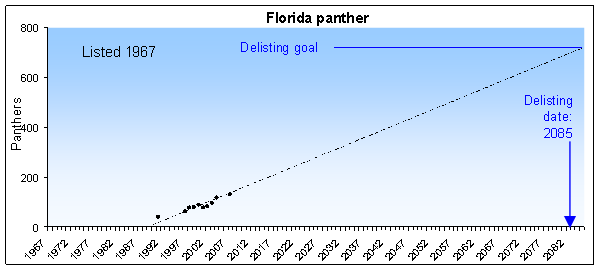
To reduce the inbreeding depression threatening to undermine the recovery program, eight reproductive females from a closely related subspecies were translocated from Texas in 1995. The panther population responded quickly, doubling in size by 2003 to 87 individuals. It has continued to grow steadily but slowly since then, reaching 130 adults in 2010.
The Florida panther’s 2008 federal recovery plan requires that the population increase to three populations, each of which must have at least 240 adults. The plan’s projected time-to-delisting to achieve this goal and delist is 2085.
The Utah prairie dog has the smallest and westernmost range of the five North American prairie dog species. It formerly occurred on 448,000 acres in southwest Utah. Its range and numbers declined in response to habitat loss caused by livestock and agriculture, a deliberate poisoning campaign by and on behalf of the livestock industry, sylvatic plague and drought. By 1995, its reach had been reduced to just 6,977 acres.
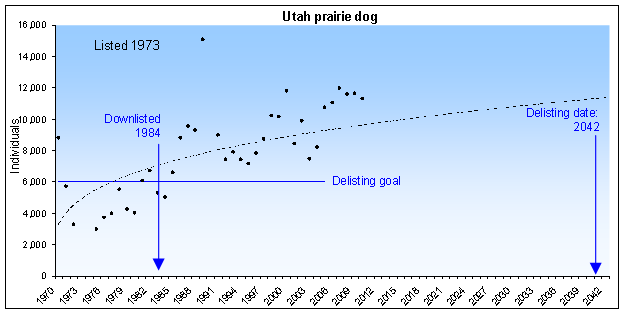
Poisoning of Utah prairie dogs by ranchers and the federal government began in the 1880s. A full-scale eradication program was launched in the 1920s. Throughout the 1920s and 1930s, tens of thousands of acres were treated with poison each year. By the time sylvatic plague was first recorded in the population in 1937, it was already significantly depleted. Poisoning programs continued into the 1950s and 1960s. By 1972 the species had been reduced to just 3,300 individuals and was predicted to become extinct by 2000. It was placed on the federal endangered species list in 1973 and began improving almost immediately. The population was estimated at 9,332 individuals by 1981. The species was downlisted to threatened in 1984. Since then the population has experienced short-term upward and downward trends, but has increased overall.
By 2010 the estimated population had risen to 11,296. Sixty-eight percent of the populations occur on private lands, where they are perceived to conflict with livestock grazing, agriculture and development. The primary management strategy before and after the 1991 federal recovery plan has been to relocate animals from conflicting private lands to locations on federal land that are at least one mile from the nearest private land border. An interagency recovery team declared in 1997 that the strategy was not working and was unlikely to ever result in the recovery of the species. The team concluded that relocations often violated recovery plan habitat requirements, were not sufficiently monitored and had a poor success rate. The team called for intensive restoration efforts on public lands to better support relocated prairie dogs, a systematic research program, a management strategy based on meta-population dynamics, and improved management of private grazing lands.
The Hawaiian goose or “nene” is Hawaii’s state bird. It inhabits shrub and grasslands and breeds and nests on the slopes of volcanoes and some lowland areas.
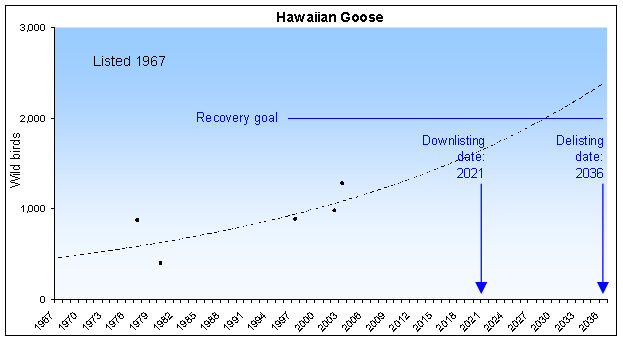
It was once found on most of the larger Hawaiian islands including Kauai, Molokai, Maui and the Big Island and may have numbered in the 20,000s prior to European settlement. As settlers moved onto the islands in the late 1770s, the nene declined due to hunting pressure. The introduction of predatory mongoose in 1883, which preyed on adults, chicks and eggs, further depressed the population. By 1918 only an estimated 30 individuals remained.
In the 1950s, captive-breeding programs were initiated in Hawaii and England. These programs eventually released more than 2,300 nenes. In 1967, due to the tenuous state of the remaining population, the nene was listed as an endangered species under the precursor to the Endangered Species Act.
Today the Hawaiian goose occurs in the wild on the islands of Hawaii, Maui (reintroduced) and Kauai (reintroduced). In order to facilitate recovery, the Hawaiian national park system provides supplemental feeding during periodic food shortages. The wild population was estimated at 1,241 individuals in 2004 and 1,744 in 2006.
(1) Scott, J.M, D.D. Goble, L.K. Svancana, and A. Pidgorna. 2006. By the numbers. In D. Goble, M. J. Scott, and F. W. Davis, editors. The Endangered Species Act 1 at Thirty: Renewing the Conservation Commitment. Island Press, Washington, DC.
(2) Suckling, K., R. Slack and B. Nowicki. 2004. Extinction and the Endangered Species Act. Center for Biological Diversity, Tucson, AZ.
(3) Hastings, D. 2011. “Excessive Endangered Species Act Litigation Threatens Species Recovery, Job Creation and Economic Growth.” Press release by Doc Hastings, Chairman of the Committee on Natural Resources, U.S. House of Representative, December 6, 2011. Available at http://naturalresources.house.gov/News/DocumentSingle.aspx?DocumentID=271408
(4) Government Accountability Office. 2006. Endangered Species: Time and Costs Required to Recover Species Are Largely Unknown. GAO-06-463R (Washington, D.C.: April 6, 2006). Available at http://www.gao.gov/assets/100/94110.pdf.
(5) Schwartz, M.W. 2008. The Performance of the Endangered Species Act. Annu. Rev. Ecol. Evol. Syst. 2008. 39:279–99
(6) Taylor, M., K. Suckling, and J. Rachlinski. 2005. The effectiveness of the Endangered Species Act: a quantitative analysis. BioScience 55: 360-367; Rachlinski J.J. 1997. Noah by the numbers: An empirical evaluation of the
Endangered Species Act. Cornell Law Review 82: 356–89; Male T. D. and M. J. Bean. 2005. Measuring progress in US endangered species conservation. Ecol Lett 8: 986–92.
(7) In other research and management contexts, we and others have challenged the adequacy of recovery plan goals for individual species and the delisting of species prior to their meeting recovery goals. This report analyzes the relationship between recovery plans and delisting decisions without judging their adequacy.
